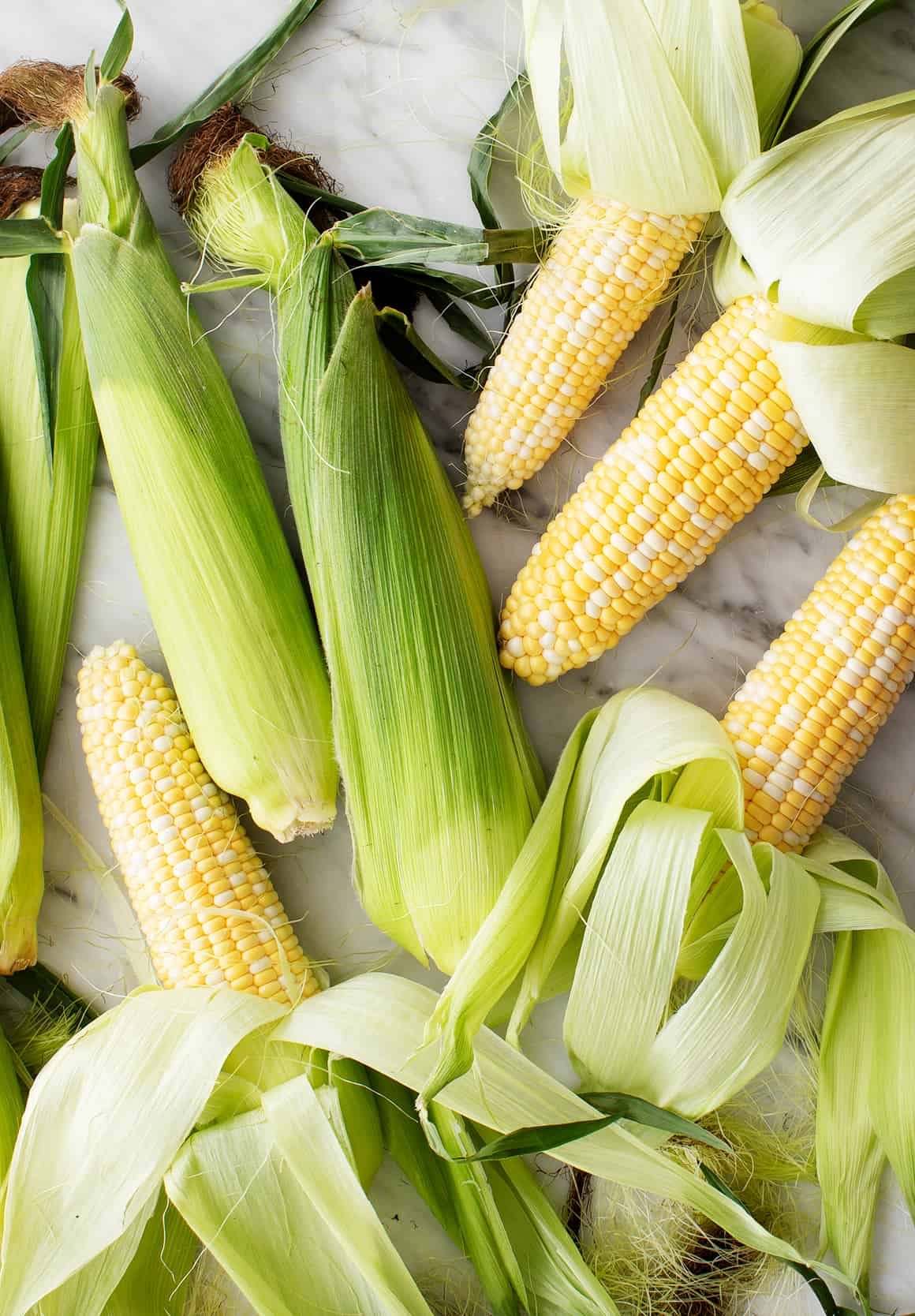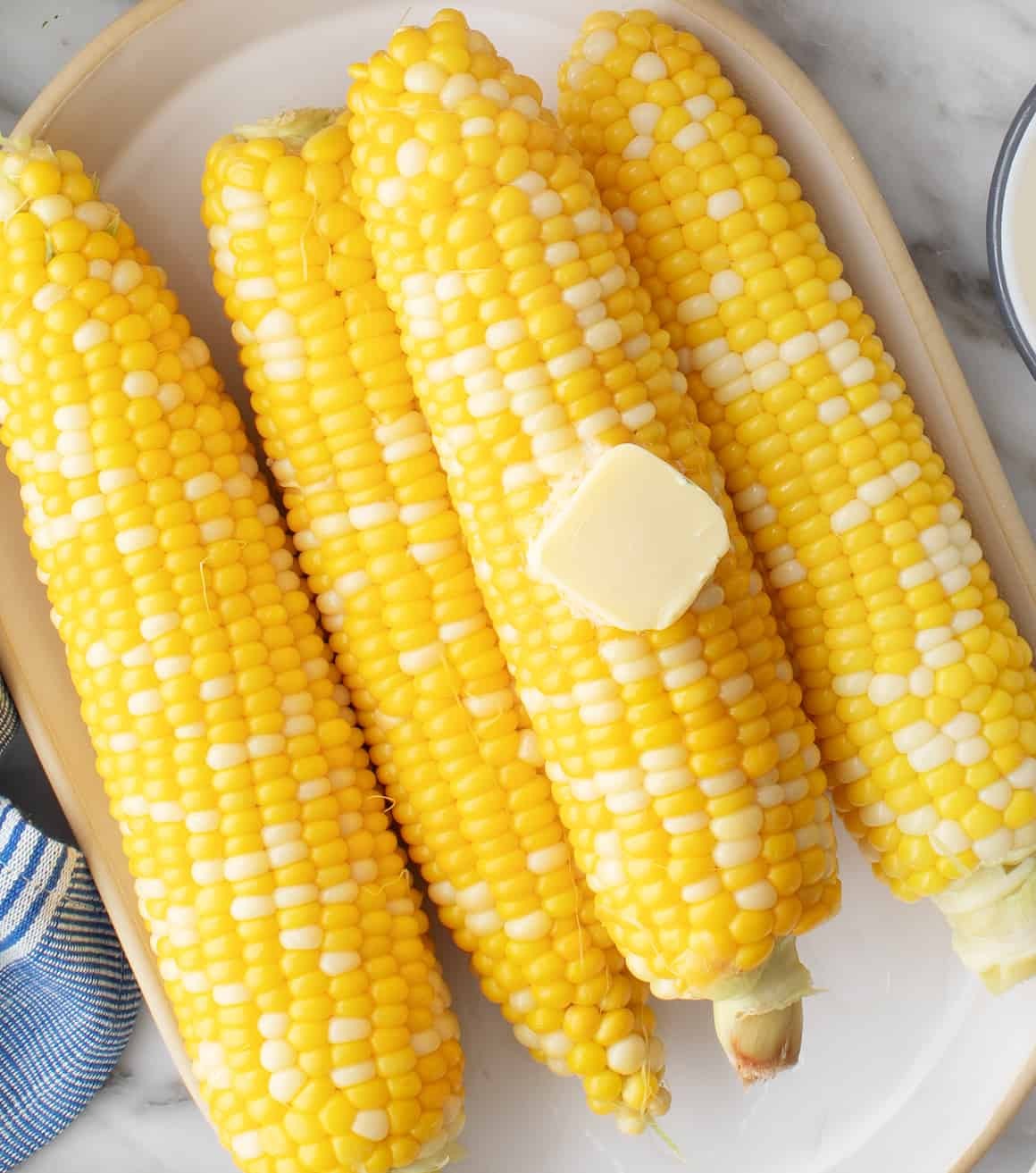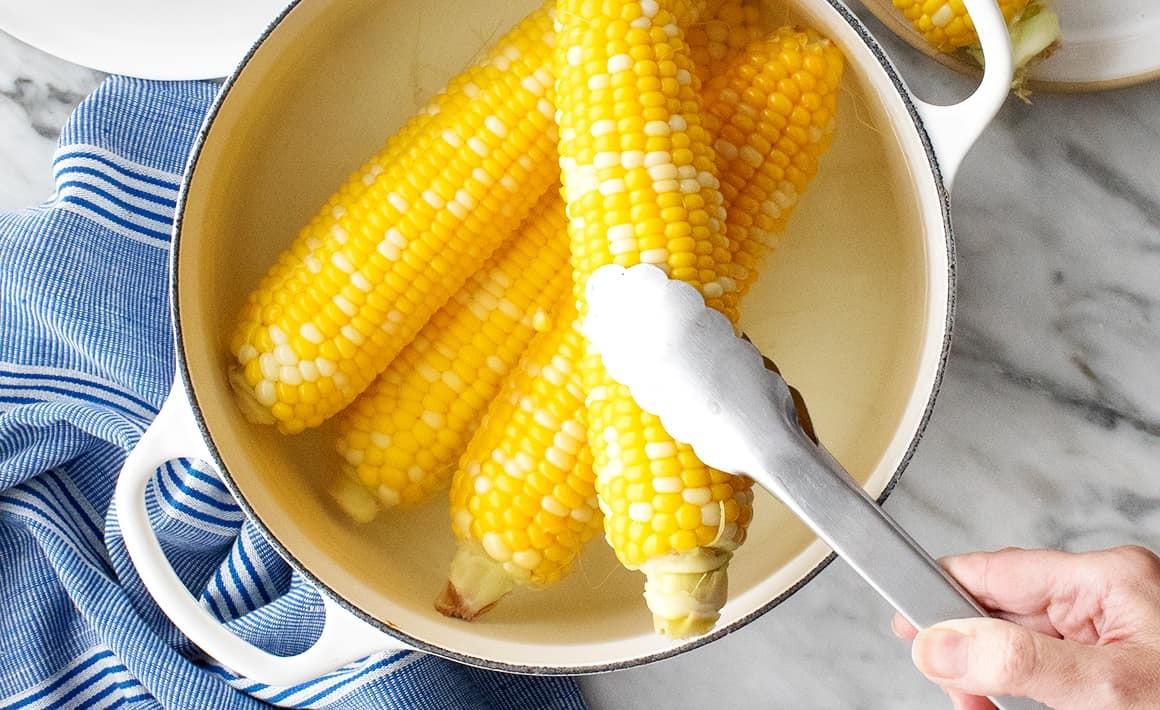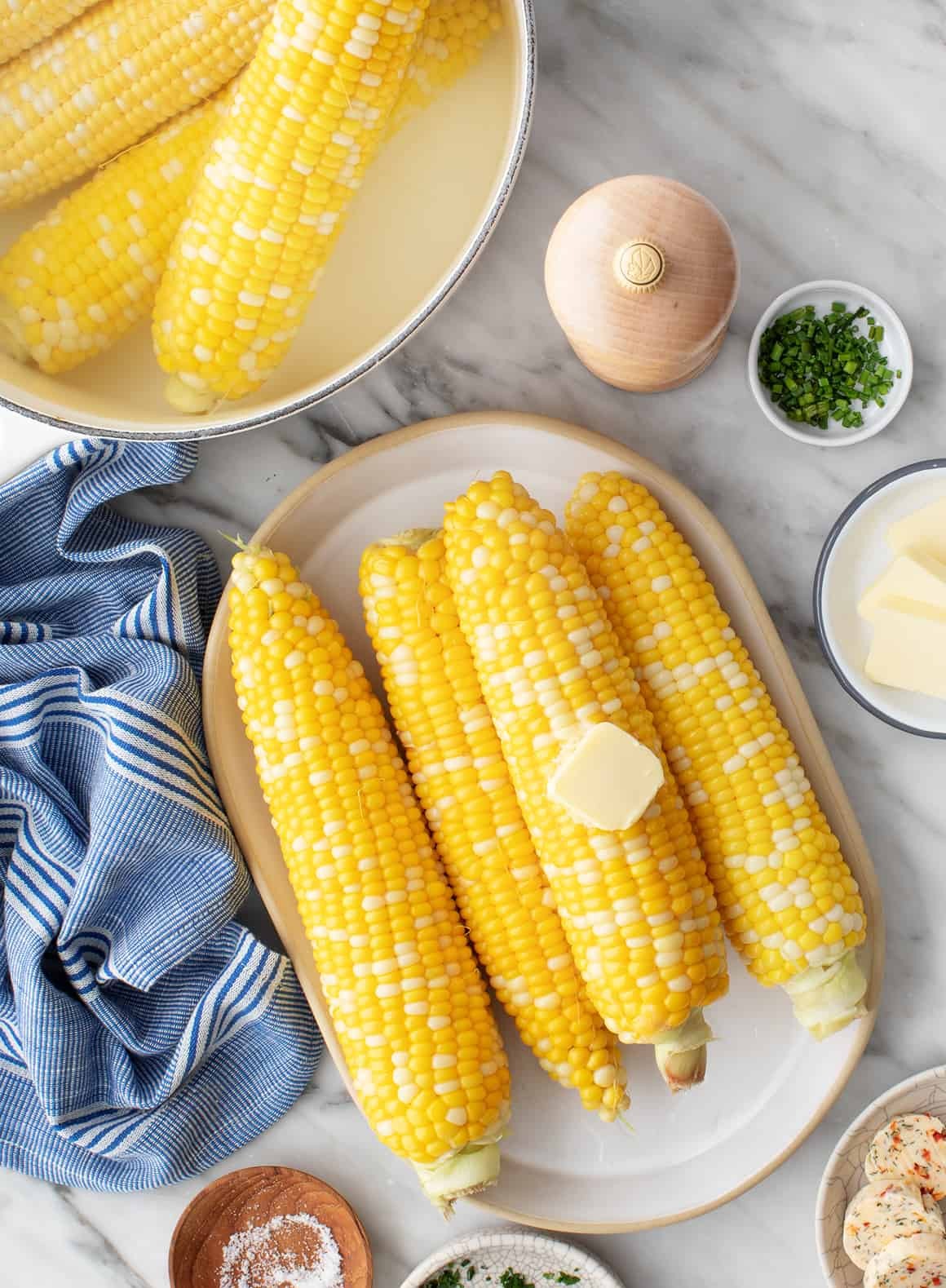How Much Time Do You Boil Corn On The Cob to achieve that perfect, tender, and sweet taste? At HOW.EDU.VN, we understand the nuances of cooking the perfect corn on the cob, providing insights that ensure your summer side dish is always a hit. Let’s explore the best practices for cooking corn on the cob.
1. What’s The Ideal Boiling Time For Corn On The Cob?
The ideal boiling time for corn on the cob typically ranges from 3 to 7 minutes, depending on your preference for tenderness and the freshness of the corn. Boiling it for this amount of time ensures the kernels are tender and juicy without becoming overcooked.
To understand the best boiling time, let’s delve into factors like corn freshness, pot size, and personal preferences. With guidance from HOW.EDU.VN, you’ll master the skill of boiling corn to perfection.
1.1. Factors Influencing Boiling Time
Several factors can influence how long to boil your corn on the cob:
- Freshness of the Corn: Freshly picked corn will cook faster and require less boiling time.
- Size of the Cob: Larger cobs may require a minute or two longer to ensure even cooking.
- Personal Preference: Some people prefer a slightly firmer kernel, while others like them very tender.
- Pot Size and Water Volume: Ensure the pot is large enough to fully submerge the corn, and the water returns to a boil quickly after adding the corn.
1.2. Step-by-Step Guide to Boiling Corn on the Cob
To achieve perfectly boiled corn, follow these steps:
- Preparation: Remove the husks and silk from the corn cobs.
- Boiling Water: Bring a large pot of water to a rolling boil.
- Submerge the Corn: Gently place the corn cobs into the boiling water, ensuring they are fully submerged.
- Boiling Time: Boil for 3 to 7 minutes. Start checking for tenderness at 3 minutes by piercing a kernel with a fork.
- Serve: Remove the corn from the pot and serve immediately with butter, salt, and any desired seasonings.
1.3. Tips for Perfect Boiled Corn
- Don’t Add Salt to the Water: Adding salt can toughen the corn.
- Use Fresh Corn: The fresher the corn, the sweeter and more tender it will be.
- Avoid Overcooking: Overcooked corn can become mushy and lose its flavor.
2. How Do You Select The Freshest Corn On The Cob?
Selecting the freshest corn on the cob is crucial for achieving the best flavor and texture when boiling. Look for tightly wrapped green husks, plump kernels, and moist silks.
The quality of corn directly impacts its taste and texture. HOW.EDU.VN can guide you through the selection process, ensuring you always choose the best corn for boiling.
2.1. Key Indicators of Fresh Corn
- Husk Appearance: The husk should be bright green, tightly wrapped around the cob, and slightly damp.
- Silk Condition: The silk (the stringy fibers at the top) should be pale gold or brown and slightly sticky. Avoid corn with dry, black silk.
- Kernel Plumpness: Feel the kernels through the husk; they should be plump and full.
- Smell: Fresh corn has a slightly sweet smell. Avoid corn that smells musty or sour.
2.2. Where to Buy Fresh Corn
- Farmers’ Markets: These are often the best places to find freshly picked corn.
- Farm Stands: Similar to farmers’ markets, farm stands offer locally grown produce.
- Grocery Stores: Look for corn that is displayed in a refrigerated section to maintain freshness.
2.3. Storing Fresh Corn
- Refrigerate Immediately: Store corn in the refrigerator as soon as possible after purchase.
- Keep Husks On: Leave the husks on to help retain moisture.
- Use Within a Few Days: For the best flavor, use the corn within one to two days.
3. What’s The Difference Between Boiling, Steaming, and Grilling Corn On The Cob?
Boiling, steaming, and grilling are three popular methods for cooking corn on the cob, each offering a unique flavor and texture. Boiling results in tender, juicy kernels, while steaming preserves more nutrients. Grilling adds a smoky char.
Understanding these differences can help you choose the best method for your taste. At HOW.EDU.VN, our experts can explain these nuances in detail.
3.1. Boiling Corn
- Pros: Quick, easy, and produces very tender and juicy corn.
- Cons: Some nutrients may be lost in the boiling water.
- Best For: Those who prefer a soft, hydrated kernel texture.
3.2. Steaming Corn
- Pros: Preserves more nutrients compared to boiling, and results in slightly firmer kernels.
- Cons: Takes a bit longer than boiling.
- Best For: Those who want to retain more nutrients and prefer a slightly firmer texture.
3.3. Grilling Corn
- Pros: Adds a smoky, charred flavor that many find appealing.
- Cons: Requires more attention to prevent burning, and the kernels can sometimes dry out.
- Best For: Those who enjoy a smoky flavor and don’t mind a slightly drier texture.
3.4. Comparison Table
| Method | Pros | Cons | Best For |
|---|---|---|---|
| Boiling | Quick, easy, very tender and juicy | Nutrient loss in water | Soft, hydrated kernel texture |
| Steaming | Preserves more nutrients, slightly firmer kernels | Takes longer than boiling | Retaining nutrients and a slightly firmer texture |
| Grilling | Smoky flavor, can be done with or without the husk | Requires more attention, can dry out kernels | Smoky flavor and don’t mind a slightly drier texture |




4. What Are Some Creative Ways To Season Boiled Corn On The Cob?
Beyond the classic butter, salt, and pepper, there are numerous creative ways to season boiled corn on the cob. Options include compound butters, flavorful sauces, fresh herbs, and spices.
Experimenting with different seasonings can elevate your corn on the cob to a gourmet level. HOW.EDU.VN offers expert advice on creative seasoning ideas to tantalize your taste buds.
4.1. Compound Butters
- Herb Butter: Mix softened butter with chopped fresh herbs like basil, parsley, and thyme.
- Garlic Butter: Combine softened butter with minced garlic and a pinch of salt.
- Chili Lime Butter: Mix softened butter with chili powder, lime zest, and a squeeze of lime juice.
- Maple Cinnamon Butter: Combine softened butter with maple syrup and cinnamon.
4.2. Flavorful Sauces
- Chipotle Sauce: Drizzle with chipotle sauce for a smoky, spicy kick.
- Vegan Ranch: Top with vegan ranch dressing for a creamy, tangy flavor.
- Pesto: Spread pesto on the corn for a burst of fresh, herbaceous flavor.
4.3. Fresh Herbs
- Cilantro: Sprinkle with fresh cilantro for a bright, citrusy note.
- Basil: Top with fresh basil for a sweet, aromatic flavor.
- Chives: Garnish with chives for a mild onion flavor.
4.4. Spices
- Smoked Paprika: Dust with smoked paprika for a smoky, slightly sweet flavor.
- Chili Powder: Sprinkle with chili powder for a spicy kick.
- Cajun Seasoning: Use Cajun seasoning for a bold, savory flavor.
4.5. International Twists
- Mexican Street Corn (Elote): Brush with mayonnaise, sprinkle with Cotija cheese, chili powder, and a squeeze of lime juice.
- Indian Spiced Corn: Rub with a mixture of butter, garam masala, turmeric, and a pinch of cayenne pepper.
- Italian Herb Corn: Drizzle with olive oil, sprinkle with Italian seasoning, and grated Parmesan cheese.
5. Can You Overcook Corn On The Cob, And What Happens If You Do?
Yes, you can overcook corn on the cob. Overcooked corn becomes mushy, loses its sweetness, and can develop a starchy taste.
Avoiding overcooking is essential for enjoying the best flavor and texture. HOW.EDU.VN offers expert guidance on how to recognize and prevent overcooking corn.
5.1. Signs of Overcooked Corn
- Mushy Texture: The kernels become soft and mushy instead of crisp and juicy.
- Loss of Sweetness: The corn loses its natural sweetness and can taste bland.
- Starchy Taste: Overcooked corn can develop a starchy, unpleasant taste.
- Pale Color: The vibrant yellow color fades, and the kernels may look pale.
5.2. How to Prevent Overcooking
- Monitor Cooking Time: Stick to the recommended boiling time of 3 to 7 minutes.
- Check for Tenderness: Test the corn by piercing a kernel with a fork. It should be tender but not mushy.
- Remove Promptly: Once cooked, remove the corn from the boiling water immediately.
- Use Fresh Corn: Fresh corn cooks faster and is less likely to become overcooked.
5.3. What to Do with Overcooked Corn
If you accidentally overcook your corn, don’t despair! Here are a few ways to salvage it:
- Corn Chowder: Use the overcooked corn in a creamy corn chowder.
- Corn Fritters: Make corn fritters by combining the kernels with flour, eggs, and seasonings.
- Corn Salad: Add the corn to a salad with other vegetables and a flavorful dressing.
- Cornbread: Incorporate the corn into cornbread for added moisture and flavor.
6. Are There Any Nutritional Benefits To Eating Boiled Corn On The Cob?
Yes, boiled corn on the cob offers several nutritional benefits. It is a good source of fiber, vitamins, and antioxidants, contributing to overall health.
Understanding these benefits can make you appreciate this summer staple even more. At HOW.EDU.VN, our nutrition experts can provide detailed insights into the health benefits of corn.
6.1. Key Nutrients in Corn
- Fiber: Aids digestion, helps regulate blood sugar levels, and promotes satiety.
- Vitamins: Contains vitamins B and C, which support various bodily functions.
- Antioxidants: Rich in antioxidants like lutein and zeaxanthin, which are beneficial for eye health.
- Minerals: Provides essential minerals such as potassium and magnesium.
6.2. Health Benefits
- Improved Digestion: The high fiber content promotes healthy digestion.
- Eye Health: Lutein and zeaxanthin help protect against age-related macular degeneration and cataracts.
- Energy Source: Provides carbohydrates for energy.
- Heart Health: Fiber helps lower cholesterol levels, promoting heart health.
6.3. Nutritional Information (per ear)
| Nutrient | Amount |
|---|---|
| Calories | Approximately 123 |
| Fiber | About 2 grams |
| Vitamin C | Around 7 mg |
| Folate | Roughly 42 mcg |
| Potassium | Approximately 270 mg |
6.4. Tips for Maximizing Nutritional Benefits
- Eat Whole Grain: Choose whole grain corn for higher fiber content.
- Avoid Excessive Butter and Salt: Limit the addition of butter, salt, and other high-calorie toppings to keep the meal healthy.
- Combine with Other Vegetables: Serve corn with other vegetables to create a balanced and nutritious meal.
7. What Are Some Common Mistakes People Make When Boiling Corn On The Cob?
Common mistakes when boiling corn on the cob include overcooking, adding salt to the water, and not using fresh corn. These errors can negatively impact the flavor and texture.
Avoiding these pitfalls will ensure your corn turns out perfectly every time. HOW.EDU.VN provides expert tips on how to avoid common mistakes.
7.1. Overcooking
- Mistake: Boiling the corn for too long, resulting in mushy and flavorless kernels.
- Solution: Stick to the recommended boiling time of 3 to 7 minutes and check for tenderness.
7.2. Adding Salt to the Water
- Mistake: Adding salt to the boiling water, which can toughen the kernels.
- Solution: Avoid adding salt to the water and season the corn after it’s cooked.
7.3. Not Using Fresh Corn
- Mistake: Using corn that is not fresh, which can result in a less sweet and flavorful taste.
- Solution: Use the freshest corn possible and store it properly in the refrigerator.
7.4. Overcrowding the Pot
- Mistake: Overcrowding the pot, which can lower the water temperature and result in unevenly cooked corn.
- Solution: Use a large pot and cook the corn in batches if necessary.
7.5. Neglecting to Remove Silk
- Mistake: Not thoroughly removing the silk from the corn, which can be unpleasant to eat.
- Solution: Take the time to remove all the silk before boiling the corn.
7.6. Not Serving Immediately
- Mistake: Letting the cooked corn sit for too long, which can cause it to become dry and lose its flavor.
- Solution: Serve the corn immediately after cooking for the best taste and texture.
8. How Can You Store Leftover Boiled Corn On The Cob?
To store leftover boiled corn on the cob, allow it to cool, wrap it tightly in plastic wrap or aluminum foil, and refrigerate it. Properly stored corn can last for up to three to five days.
Knowing how to store leftovers ensures you can enjoy your corn for days. HOW.EDU.VN offers expert tips on storing and reheating corn on the cob.
8.1. Cooling the Corn
- Allow to Cool: Let the corn cool completely before storing it. This prevents condensation from forming, which can make the corn soggy.
- Pat Dry: Gently pat the corn dry with a paper towel to remove excess moisture.
8.2. Wrapping and Storing
- Plastic Wrap: Wrap each ear of corn tightly in plastic wrap.
- Aluminum Foil: Alternatively, wrap the corn in aluminum foil.
- Airtight Container: Place the wrapped corn in an airtight container for added protection.
- Refrigerate: Store the corn in the refrigerator at a temperature of 40°F (4°C) or below.
8.3. Reheating Leftover Corn
- Boiling: Reheat the corn by briefly boiling it for 1 to 2 minutes.
- Steaming: Steam the corn for 3 to 5 minutes.
- Microwaving: Microwave the corn for 1 to 2 minutes, covered with a damp paper towel.
- Grilling: Grill the corn for a few minutes, turning occasionally, to add a smoky flavor.
8.4. Tips for Storing and Reheating
- Use Promptly: For the best taste and texture, use the leftover corn within three to five days.
- Add Moisture: When reheating, add a little moisture to prevent the corn from drying out.
- Avoid Overheating: Be careful not to overheat the corn, as it can become tough.
9. Can You Freeze Boiled Corn On The Cob?
Yes, you can freeze boiled corn on the cob. To do so, blanch the corn, cool it, and then freeze it in airtight containers or freezer bags. Frozen corn can last for up to eight to twelve months.
Freezing corn is a great way to preserve its flavor and enjoy it year-round. HOW.EDU.VN provides expert tips on how to freeze and thaw corn properly.
9.1. Blanching the Corn
- Boil Water: Bring a large pot of water to a rolling boil.
- Blanch: Place the corn in the boiling water for 3 to 5 minutes.
- Cool Immediately: Remove the corn and plunge it into a bowl of ice water to stop the cooking process.
9.2. Preparing for Freezing
- Dry the Corn: Pat the corn dry with a paper towel.
- Cut Kernels (Optional): You can freeze the corn on the cob or cut the kernels off the cob.
- Wrap or Bag: Wrap each ear of corn tightly in plastic wrap or place the kernels in freezer bags.
- Remove Air: Remove as much air as possible from the freezer bags to prevent freezer burn.
9.3. Freezing
- Label and Date: Label the bags or containers with the date and contents.
- Freeze: Place the corn in the freezer at a temperature of 0°F (-18°C) or below.
9.4. Thawing and Using Frozen Corn
- Thaw: Thaw the corn in the refrigerator overnight or use it directly from frozen in cooked dishes.
- Cooking: Cook the thawed corn as you would fresh corn, adjusting the cooking time as needed.
9.5. Tips for Freezing and Thawing
- Blanching is Key: Blanching helps preserve the color, flavor, and texture of the corn.
- Proper Packaging: Use airtight packaging to prevent freezer burn.
- Use Promptly: Use the frozen corn within eight to twelve months for the best quality.
10. What Are Some Delicious Recipes That Use Boiled Corn Kernels?
Boiled corn kernels can be used in a variety of delicious recipes, including salads, soups, salsas, and side dishes. Their sweet, juicy flavor enhances many meals.
Exploring these recipes can inspire you to get creative in the kitchen. HOW.EDU.VN offers expert advice on delicious ways to use boiled corn kernels.
10.1. Corn Salad
- Ingredients: Corn kernels, chopped bell peppers, red onion, cilantro, lime juice, olive oil, salt, and pepper.
- Instructions: Combine all ingredients in a bowl and toss. Serve chilled.
10.2. Corn Chowder
- Ingredients: Corn kernels, potatoes, onions, celery, vegetable broth, milk or cream, butter, salt, and pepper.
- Instructions: Sauté onions and celery in butter. Add potatoes and broth and simmer until tender. Add corn kernels and milk or cream. Season with salt and pepper.
10.3. Corn Salsa
- Ingredients: Corn kernels, black beans, diced tomatoes, red onion, jalapeño, cilantro, lime juice, salt, and pepper.
- Instructions: Combine all ingredients in a bowl and toss. Serve with tortilla chips or as a topping for grilled meats.
10.4. Corn Fritters
- Ingredients: Corn kernels, flour, eggs, milk, baking powder, sugar, salt, and pepper.
- Instructions: Mix all ingredients in a bowl. Drop spoonfuls of batter into hot oil and fry until golden brown.
10.5. Cornbread
- Ingredients: Cornmeal, flour, baking powder, sugar, salt, eggs, milk, butter, and corn kernels.
- Instructions: Mix dry ingredients, then add wet ingredients and corn kernels. Pour batter into a greased baking pan and bake until golden brown.
10.6. Creamed Corn
- Ingredients: Corn kernels, butter, flour, milk or cream, sugar, salt, and pepper.
- Instructions: Melt butter in a saucepan, then whisk in flour. Gradually add milk or cream, stirring until smooth. Add corn kernels, sugar, salt, and pepper. Simmer until thickened.
FAQ: Mastering Corn On The Cob Boiling Techniques
Q1: How do I know when the corn is perfectly boiled?
A1: The kernels should be tender and easily pierced with a fork. The color will be bright yellow.
Q2: Can I boil corn with the husks on?
A2: Yes, boiling corn with the husks on can add flavor and moisture, but it may take slightly longer to cook.
Q3: Is it necessary to add sugar to the boiling water?
A3: Adding sugar is not necessary. Fresh corn is naturally sweet, and sugar can make it too sweet.
Q4: How long can I store boiled corn in the refrigerator?
A4: Boiled corn can be stored in the refrigerator for up to three to five days if properly wrapped.
Q5: What is the best way to reheat boiled corn?
A5: You can reheat boiled corn by boiling, steaming, microwaving, or grilling it briefly.
Q6: Can I use frozen corn on the cob for boiling?
A6: Yes, but it may take slightly longer to cook. Ensure the corn is thawed partially before boiling.
Q7: Does the type of pot affect the boiling time?
A7: The pot material does not significantly affect the boiling time, but the size does. Use a large pot to fully submerge the corn.
Q8: Can I add lemon juice to the boiling water?
A8: Adding lemon juice can add a subtle citrus flavor to the corn.
Q9: What are the best toppings for boiled corn on the cob?
A9: Popular toppings include butter, salt, pepper, compound butters, flavorful sauces, fresh herbs, and spices.
Q10: How do I prevent the corn from floating in the pot?
A10: Use a heavy plate or lid to weigh down the corn and keep it submerged in the boiling water.
Are you looking for personalized advice on cooking corn on the cob? Do you have specific questions about the best techniques or seasoning ideas? At HOW.EDU.VN, we connect you with leading experts who can provide tailored guidance to meet your needs.
Our team of over 100 Ph.D. experts from around the world is ready to assist you. We understand the challenges of finding reliable and trustworthy advice, which is why we’ve made it our mission to provide access to top-tier expertise.
Connect with Experts at HOW.EDU.VN
- Personalized Advice: Get customized tips and solutions for your specific cooking questions.
- Expert Guidance: Benefit from the knowledge of Ph.D. experts in nutrition and culinary arts.
- Convenient Access: Reach experts from anywhere in the world, right from your home.
- Trusted Information: Ensure you’re receiving accurate and reliable advice.
Don’t struggle with uncertainty. Contact HOW.EDU.VN today and let our experts guide you to success. Reach out to us for a consultation, and let’s turn your challenges into triumphs.
Address: 456 Expertise Plaza, Consult City, CA 90210, United States
WhatsApp: +1 (310) 555-1212
Website: how.edu.vn
